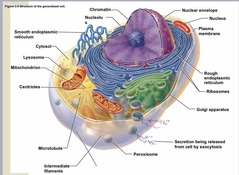![]()
![]()
![]()
Use LEFT and RIGHT arrow keys to navigate between flashcards;
Use UP and DOWN arrow keys to flip the card;
H to show hint;
A reads text to speech;
17 Cards in this Set
- Front
- Back

|
Structure of the generalized cell |
|
|
Anatomy of a Generalized Cell |
Nucleus Cytoplasm Plasma Membrane |
|
|
Nucleus |
• control center of the cell • contains DNA: needed for building proteins, necessary for cell reproduction |
|
|
3 regions of the nucleus |
1. Nuclear envelope: membrane of nucleus 2. Nucleolus: site of ribosome assembly 3. Chromatin: DNA wound around proteins |
|
|
The Plasma Membrane |
Transparent barrier Structure has: •Phospholipid bi-layer (2 layers of phospholipids: heads-hydrophilic, tails-hydrophobic. Arranged “tail to tail”) •cholesterol •protein |
|
|
Role of proteins |
Specialized membrane functions: •enzymes •hormone receptors •transports channels or carriers |
|
|
Cytoplasm |
•cellular material (Outside the nucleus and inside the plasma membrane) •site of most cellular activities •includes cytosol and organelles |
|
|
3 major components of Cytoplasm |
1. Cytosol: fluid that suspends other elements. Contains nutrients and electrolytes 2. Inclusions: chemical substances, such as stored nutrients or cell products, that float in the cytosol 3. Organelles: cellular parts that perform work |
|
|
Mitochondria |
“Powerhouses” of the cell. Carry out reactions to break down food into ATP molecules. |
|
|
Ribosome |
Protein and ribosomal RNA. Site of protein synthesis in the cell |
|
|
Rough Endoplasmic reticulum |
Studded with ribosomes. Synthesizes proteins. Transports vesicles move proteins within cells. |
|
|
Smooth endoplasmic reticulum |
Lacks ribosomes. Functions in lipid metabolism. Detoxification of drugs and pesticides. |
|
|
Golgi body/ apparatus |
Appears as a stack of flattened membranes. Modified and packaged proteins arriving from the rough endoplasmic reticulum via transport vesicles. Produces different types of packages: secretory vesicles (pathway 1) in house proteins and lipids (pathway 2) lysosomes (pathway 3) |
|
|
Lysosomes |
Garbage disposal of the cell: membranes “bags” containing digestive enzymes. Digests worm-our or non usable cell structures. House phagocytes that dispose of (eat) bacteria and cell debris. |
|
|
Peroxisomes |
Membranous sacs of oxidase enzyme: detoxify harmful substances (such as alcohol and formaldehyde). Break down free radicals (highly reactive chemicals). Free radicals -> hydrogen peroxide-> water |
|
|
Cytoskeleton = cell skeleton |
Network of protein structures that extend throughout the cytoplasm. Determined cell shape. Support organelles. Provides machinery for intercellular transport. |
|
|
Centrioles |
Rod shaped bodies. Generate microtubules. Direct the formation of miotic spindle during cell division. |

